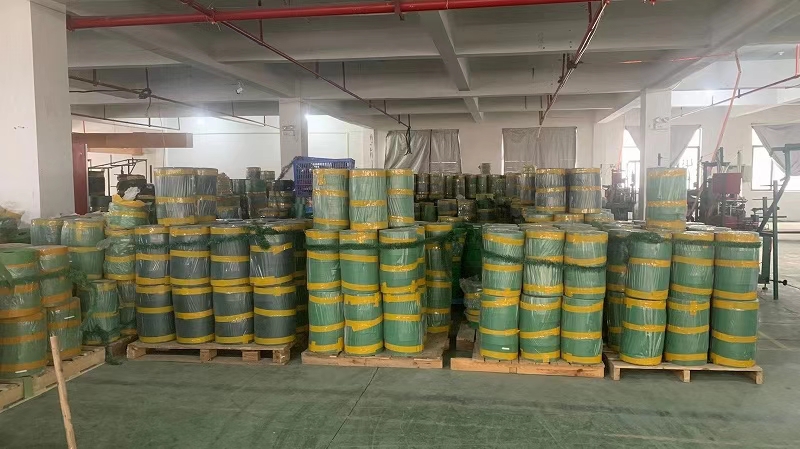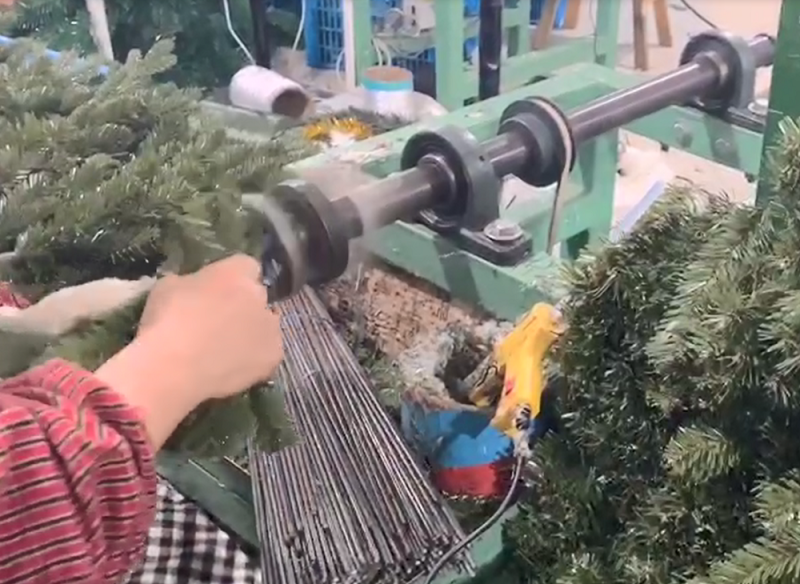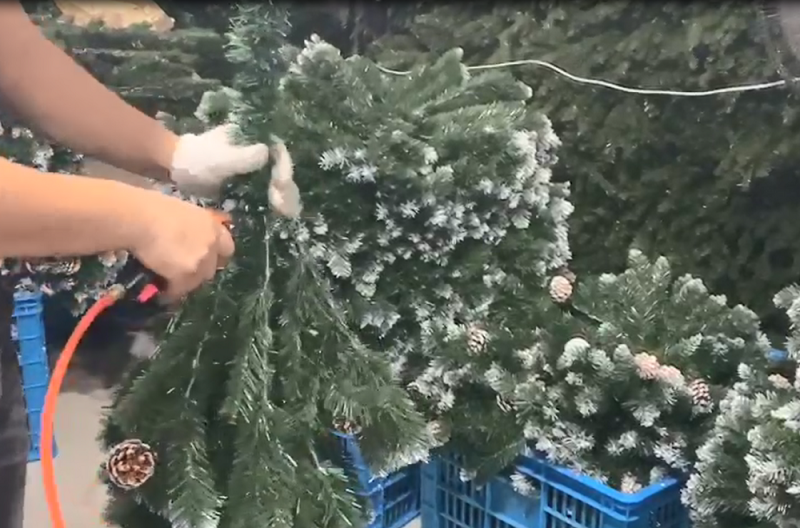How To Produce An Artificial Christmas Tree?
It is an article on how to produce an artificial Christmas tree.
Nowadays, two main types of Christmas trees are used to celebrate Christmas in the world: real Christmas trees and artificial Christmas trees. With the increasing demand for Christmas trees worldwide, artificial Christmas trees are becoming an indispensable choice for Christmas.
Compared with the real tree planted, this is easy to understand, many people are very curious about how the artificial one is made. Before introducing the production process, let’s first learn what an artificial Christmas tree is.
What is an artificial Christmas tree?
Briefly, the world’s first artificial Christmas tree was born in Germany in the 19th century. At that time, it was made of goose feathers and then dyed green. This is the prototype of the first artificial Christmas tree. In the 1880s, the artificial Christmas tree became more and more popular.
Wikipedia defines it like this: An artificial Christmas tree is an artificial pine or fir tree manufactured for the specific purpose of use as a Christmas tree. The earliest artificial Christmas trees were wooden, tree-shaped pyramids or feather trees, both developed by Germans. Most modern trees are made of polyvinyl chloride (PVC) but many other types of trees have been and are available, including aluminum Christmas trees and fiber-optic illuminated Christmas trees.
So, how are modern artificial Christmas trees produced?
How to produce artificial Christmas trees
Step #1 Prepare raw materials

When the artificial Christmas tree first became popular, the material of the Christmas tree only included PVC, steel trunk, iron wire, tree stands, binding string, and so on. Nowadays, with the emergence of various Christmas tree designs and the continuous development of raw materials, the raw materials are much expanded. In addition to the just mentioned ones, there are also PE in various colors and shapes. , pine needles, PVC, PET, moreover, Christmas tree decorations are much favored, such as Christmas tree lights, pine cones, red berries, Christmas balls, Christmas flowers, withered Branches, and some other special decorations.
All in all, the above raw materials need to be prepared according to the Christmas tree design to make.
Step #2 Inspect Materials

After the materials are collected at the warehouse, we need to carry out a very important step: to inspect all the ready materials, including the color, size, weight, surface treatment, environmental standard, durability, damage, and defects;
Picking out potential defective materials is vital for the upcoming production quality.
After these checks are done, we will proceed to the next step:
Step #3 Pull branches

Normally, the on-sale Christmas tree branches are all very stereoscopic in various shapes; however, they are originally flat and have no support. To proceed, we need to pull and combine it with the iron wire with a branch-pulling machine. (Only PVC and pine needles need to be pulled in this way. PE branches are made with abrasive tools, and the production process is different.)
The branch-pulling process is highly automated. The machine will run automatically after setting by workers. Now, the branch came out with the wanted width and size, but the length is all around 5 meters, we certainly won’t use such a long branch on the artificial Christmas tree, so let’s go to the next step.
Step #4 Cut branches

We will use the set branch sizes on the tree, like 8 inches long, so we need to cut the 5-meter branches into 8 inches long, this process is Cut Branches, which can be completed by a human + cutting machine or automatic cutting machine. Certainly, what we are talking about now is only the common branch shape, sometimes we need some special shapes, such as sharp and cone tips, which need to be specially processed by the machine. We will introduce it in another topic.
Great, we now have the branches of the right length, but still individual branches, just like pieces of leaves on a tree, so the next step is to tie the leaves to the metal trunk.
Step #5 Tie branches

Tying branches is to tie individual leaves to a thicker iron wire. It is carried out by workers and machines. By the way, automatic branch-tying machines are commonly applied now, but it is not 100% automatic and needs assistance from workers. Tying branches requires high proficiency of workers. They will tie branches and some decorations according to the shape of the design. They have to be careful enough, otherwise, any mistakes will affect the shape of the whole tree. With more than 10 years of work experience, the workers at Kayn Christmas can do the job proficiently and rarely make mistakes. The branches of each layer are carefully marked for easy assembly.
OK, we now have a branch for layers, and some prototypes appear.
Let’s move on to the next step:
Step #6 Assembly

If it is a basic and simple Christmas tree, assembly is the last step; assembly refers to assembling all the branches to the trunk. The trunk is generally made of steel. According to different structures, the assembly method also varies
- Wrapped structure:
A wrapped tree means all the branches are tied to the trunk. This seems to be similar to step 5, except everything is larger and more complicated; when tying the branches, we use a larger machine to carry out the final step. After it is done, the entire Christmas tree is completed, but it is in a gathered shape. If you want to see the shape of a tree, you need to stand it up and open each branch. How to properly open a Christmas tree? This will be introduced later.
- Hinged structures:
Hinged trees and wrapped trees are the main structures of artificial Christmas trees. The hinged tree means each branch is fixed with a nail on the hinged trunk. This structure will save you much time when opening the Christmas tree. But for production, this structure will take more time, so the cost is higher than the wrapped tree.
- Hanging structure
Hanging structure is not common, it is only popular in certain markets or a small group of buyers, hanging trees, namely, is to hang each branch on the trunk, but this step is not in the production stage, consumers are required to hang the branches by themselves. The clear serial number is marked on each branch for assembly. You can hang it according to our instructions, and it can also be taken off at any time. Obviously, it is very convenient for storage after Christmas.
Step #7 Flocking, Frost, Pre-lit
Now, numerous people like trees with a special look, not just green branches. The most common ones are pre-lit Christmas trees, flocking and frost trees, etc. These processes all require that trees are assembled and open, these special treatments make the tree extremely unique.
Step #8: Packaging
The last step is packaging for a ready-to-sell Christmas tree, there are multiple options for packaging, such as cardboard boxes, color boxes, and storage bags, these are some of the main packaging methods, of course, special packaging can also be customized, after package, Christmas trees will be sent to every family for celebrating Christmas.
Conclusion
In summary, there are 8 main steps in the production of an artificial Christmas tree, but there are a lot more in the production process. At Kayn Christmas, we will have repeated confirmation and inspection in each step to ensure product quality.
So let’s recap the main steps:
Step#1: Prepare raw materials
Step#2: Inspect Materials
Step#3: Pull branches
Step #4: Cut branches
Step #5: Tie branches
Step #6: Assembly
Step#7: Flocking, Frost, Pre-lit
Step #8: Packaging
The above is all about the introduction of how to produce an artificial Christmas tree. I hope it can solve your doubts about the artificial Christmas tree. For more information, please visit our website www.kaynchristmastree.com, have a good day!

